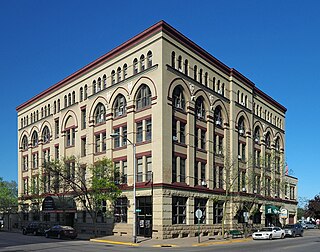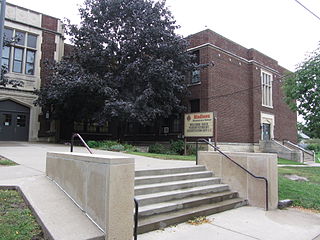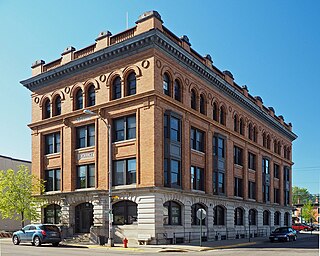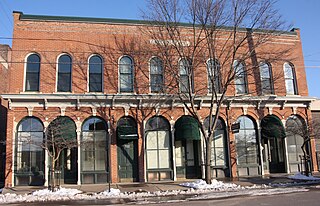
Winona station, formerly known as the Chicago. Milwaukee & St. Paul Railway Station, is a historic train station in Winona, Minnesota, United States. It is served by Amtrak's daily Empire Builder service. It was originally built in 1888 by the Chicago, Milwaukee, St. Paul and Pacific Railroad, known later as the Milwaukee Road. A former Milwaukee Road freight house also exists here.

Merchants National Bank is a bank building in Winona, Minnesota, United States, designed in the Prairie School architectural style. It was built in 1912 and features elaborate terracotta and stained-glass ornamentation. It was listed on the National Register of Historic Places in 1974 for having state-level significance in the themes of architecture and commerce. It was nominated for being the "largest and probably best example" of the 18 Midwestern banks designed by Purcell, Feick & Elmslie, a significant influence on early-20th-century American architecture. It is also a contributing property to the Winona Commercial Historic District.

This is a list of the National Register of Historic Places listings in Winona County, Minnesota. It is intended to be a complete list of the properties and districts on the National Register of Historic Places in Winona County, Minnesota, United States. The locations of National Register properties and districts for which the latitude and longitude coordinates are included below, may be seen in an online map.

The Winona Hotel is a former hotel building in Winona, Minnesota, United States, constructed in 1889. It was listed on the National Register of Historic Places in 1983 for having local significance in the themes of architecture and commerce. It was nominated for its locally distinctive Romanesque Revival architecture and origin as a hotel specifically constructed to accommodate out-of-town visitors during Winona's heyday as a fine theatre destination. The Winona Hotel is also a contributing property to the Winona Commercial Historic District. Now known as The Kensington, the building has been converted to senior apartments.

The Basilica of Saint Stanislaus Kostka is a historic church of the Roman Catholic Diocese of Winona in Winona, Minnesota, United States, and a prominent fixture on the city's skyline. Within the diocese it is better known as Saint Stan's. It was listed on the National Register of Historic Places in 1984 as Church of St. Stanislaus–Catholic and was designated as a Minor Basilica of the Roman Catholic Church on November 10, 2011 by Pope Benedict XVI.

The Old Winona Middle School is a former school complex in Winona, Minnesota, United States. The east building was originally constructed as the Winona High School from 1915 to 1917 and the west building was added as the Winona Junior High School in 1926. An auditorium was added to the rear of the east building in 1928. In 1988 the complex became the Winona Middle School. The property was listed on the National Register of Historic Places as the Winona High School and Winona Junior High School in 2004 for its local significance in the theme of education. It was nominated for representing local efforts to implement progressive educational trends in updated facilities, while offering cultural experiences to the wider community through professional music performances in the auditorium.

Winona City Hall is the seat of municipal government for Winona, Minnesota, United States. It was built with federal funding from the Public Works Administration in 1939.

The Winona and St. Peter Railroad Freight House is a former freight house in Winona, Minnesota, United States. Built from 1882 to 1883, it is the city's last surviving freight facility of the Winona and St. Peter Railroad. The building was listed on the National Register of Historic Places in 1984 for having local significance in the theme of transportation. It was nominated as a symbol of the Winona and St. Peter Railroad, which was instrumental in spurring Winona's industry and growth by developing markets along its rail lines across Minnesota and into Dakota Territory.
Routledge & Hertz was an architectural and engineering firm of Hutchinson, Kansas which was organized in 1925 and operated through 1932.

The Watkins Manor House is a historic mansion in Winona, Minnesota, United States. It was built from 1924 to 1927 for Paul Watkins (1865–1931), second-generation leader of the J.R. Watkins Company and progenitor of its famous door-to-door sales strategy. It was designed in the Jacobethan style by architect Ralph Adams Cram. The house was listed on the National Register of Historic Places in 1984 as the Paul Watkins House for its local significance in the themes of architecture and commerce. It was nominated for its associations with Paul Watkins and the Watkins Company, and for its architecture, being a rare and unaltered example of a house designed by an architect better known for his churches and institutional buildings.

Washington–Kosciusko Elementary School is an elementary school in Winona, Minnesota, United States. Its building was constructed in 1934, the fourth of five new facilities built by Winona Public Schools in the early 20th century to implement progressive educational reforms. It was listed on the National Register of Historic Places in 2012 for its significance in the theme of education. It was nominated for representing the 20th-century development of Winona Public Schools and for being a project of the Public Works Administration, the largest federal relief program of the New Deal.

The Schlitz Hotel is a former hotel and saloon in Winona, Minnesota, United States. It operated from 1892 to 1921 as one of many such establishments commissioned around the Upper Midwest by the Joseph Schlitz Brewing Company of Milwaukee. The building was listed on the National Register of Historic Places in 1982 for its local significance in the themes of architecture and commerce. It was nominated for being a well-preserved example of this once-common business venture by breweries. In 1998 the Schlitz Hotel was also included as a contributing property of the Winona Commercial Historic District.

Madison Elementary School was an elementary school in Winona, Minnesota, United States. The building was constructed in 1932, the third of five new facilities built by Winona Public Schools in the early 20th century. It was listed on the National Register of Historic Places in 2012 for its local significance in the theme of education. It was nominated for representing the efforts of Winona Public Schools to implement progressive educational reforms such as separated grades, kindergartens, gymnasiums, art and music classrooms, and improved hygiene and fire safety.

The Huff–Lamberton House is a historic house in Winona, Minnesota, United States. It was built in 1857, and in 1873 it was given a Moorish Revival porch. It was listed on the National Register of Historic Places in 1976 for its state-level significance in the theme of architecture. It was nominated for being one of Minnesota's oldest and best preserved Italian Villa style houses.

The Abner F. Hodgins House is a historic house in Winona, Minnesota, United States. It was built in 1890 for Hodgins (1826–1896), a successful lumber executive. The house was listed on the National Register of Historic Places in 1984 for its local significance in the themes of architecture and industry. It was nominated for being an outstanding example of a Queen Anne-style house and for being the home of a notable leader in the key industry behind Winona's early prominence.

The Grain and Lumber Exchange Building is a historic office building in Winona, Minnesota, United States. It was designed in Renaissance Revival style by the architectural firm of Kees & Colburn and built in 1900. The building was listed on the National Register of Historic Places in 1977 for its local significance in the theme of architecture. It was nominated for being among Winona's most architecturally distinctive office buildings from the turn of the 20th century. It is also notable for being designed to the specifications of its first tenants even though they were primarily renters rather than owners.

The Benjamin Ellsworth House is a historic house in Utica, Minnesota, United States. It was built in 1873 for Benjamin Ellsworth (1826–1890), the founder of Utica. The building was listed on the National Register of Historic Places in 1984 for its local significance in the themes of architecture and exploration/settlement. It was nominated for its associations with Ellsworth and for the degree of preservation of its original design.

The East Second Street Commercial Historic District is a small historic district in Winona, Minnesota, United States. It comprises 14 contributing properties mostly built in the late 1860s. The district was listed on the National Register of Historic Places in 1991 for its state-level significance in the themes of architecture and commerce. It was nominated for being one of the few surviving remnants of the original business district of a Minnesota river town, and for being a symbol of Winona's swift growth as a lumber and grain trade center.

Anger's Block is a historic commercial building in Winona, Minnesota, United States. Built in 1872, it is one of the oldest surviving commercial buildings in Winona's central business district. The building was listed on the National Register of Historic Places in 1978 for its local significance in the theme of architecture. It was nominated for its early status among Winona's downtown buildings, which is furthered by the survival of its original architectural plans. In 1998 the building was also listed as a contributing property to the Winona Commercial Historic District.

Central Grade School is an elementary school in Winona, Minnesota, United States. Its building was constructed in 1930, the first of five new facilities built by Winona Public Schools in the early 20th century. It was listed on the National Register of Historic Places in 2012 for its local significance in the theme of education. It was nominated for representing the efforts of Winona Public Schools to implement progressive educational reforms such as separated grades, kindergartens, gymnasiums, art and music classrooms, and improved hygiene and fire safety features.























